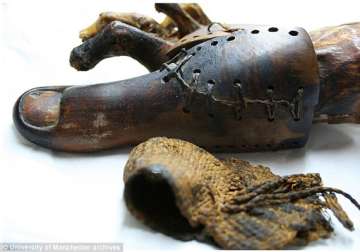London, Oct 3: Ancient Egyptians from 950 B.C. were probably the world's first to make prosthetic toes, and they still work today, according to a British research.
Researcher Jacky Finch from the University of Manchester wanted to find out how successful two discovered toes were at helping people walk, the Daily Mail reported.
One toe was created from wood and leather, and dates from between 950 to 710 B.C. It was found on a female mummy buried near Luxor in Egypt.
The second is called the “Greville Chester” artificial toe from before 600 B.C. It was made of cartonnage—a sort of papier mache mixture made using linen, glue and plaster.
Both display significant signs of wear, and their design also suggest they may have been more than cosmetic additions.
”There are many instances of the ancient Egyptians creating false body parts for burial but the wear plus their design both suggest they were used by people to help them to walk,” Finch told the daily.
Finch recruited two volunteers who were both missing their right big toe.
Design replicas of the ancient toes were made to fit each volunteer along with replica leather ancient Egyptian-style sandals.
Each volunteer was asked to walk on a 10-metre walkway bare foot, in their own shoes and wearing the replicas with and without the sandals.
Their movement was tracked using 10 cameras and the pressure of their footsteps was measured using a mat.
The 10 best walking trials were recorded for each foot, using their normal left foot as the control.
Both volunteers were able to walk using these devices although one volunteer performed much better than the other.
When wearing the sandals with the cartonnage replica, one of the volunteers achieved 87 percent of the flexion achieved by their normal left toe.
The ability to push off using the prosthetic toe was not as good when the volunteer was not wearing the sandals.
The second volunteer was still able to produce between 60-63 percent flexion wearing the replicas with or without the sandals.
Describing the performance of the three-part wooden and leather toe, both volunteers found it to be extremely comfortable, scoring it highly. One volunteer commented that with time he could get used to walking in it.
The findings from this study, which have been published in full in the Journal of Prosthetics and Orthotics, means the earliest known prosthetic is now more likely to come from ancient Egypt.
Latest World News
